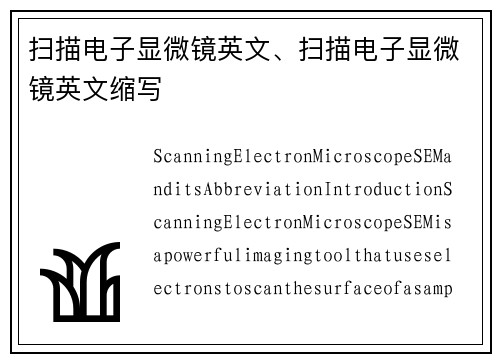扫描电子显微镜英文、扫描电子显微镜英文缩写
Scanning Electron Microscope (SEM) and its Abbreviation
Introduction
ag真人九游会
Scanning Electron Microscope (SEM) is a powerful imaging tool that uses electrons to scan the surface of a sample to create a highly magnified image. The SEM has become an essential tool in research and industry for examining the morphology, composition, and topography of materials. In this article, we will explore the SEM and its abbreviation in detail.
Background
The first SEM was developed in 1938 by Manfred von Ardenne in Germany. However, it was not until the 1960s that the SEM became widely used due to the development of high-resolution detectors and computers. Today, SEMs are used in a variety of fields, including materials science, biology, chemistry, and physics.
Detailed Explanation
1. Principle of SEMThe SEM works by generating a beam of electrons that is focused onto the surface of a sample. When the electrons hit the sample, they interact with the atoms and produce signals that are detected by a detector. These signals are then used to create an image of the surface of the sample.
2. Components of SEMThe SEM consists of several components, including an electron source, an electron column, a sample stage, detectors, and a computer. The electron source produces a beam of electrons that is focused by the electron column onto the sample. The sample stage holds the sample and allows it to be moved and rotated. Detectors detect the signals produced by the interaction of the electrons with the sample, and the computer processes the signals to create an image.
3. Advantages of SEMThe SEM has several advantages over other imaging techniques. It can produce high-resolution images of the surface of a sample with a magnification of up to 500,000 times. It can also provide information about the composition and topography of the sample. Additionally, the SEM can be used to examine samples that are too small or too thin to be examined by other techniques.
4. Applications of SEMThe SEM has a wide range of applications in various fields. In materials science, it is used to examine the microstructure of materials, such as metals, ceramics, and polymers. In biology, it is used to examine the structure of cells and tissues. In chemistry, it is used to examine the surface of catalysts and nanoparticles. In physics, it is used to examine the structure of materials at the nanoscale.
5. Limitations of SEMThe SEM also has some limitations. It can only examine the surface of a sample and cannot provide information about the internal structure. It also requires a vacuum environment, which can limit the types of samples that can be examined. Additionally, the SEM can be expensive to operate and maintain.
6. Abbreviation of SEMThe abbreviation of Scanning Electron Microscope is SEM. It is a widely used abbreviation in the scientific community and is recognized internationally. The abbreviation is often used in scientific papers, presentations, and discussions.
Conclusion
In conclusion, the Scanning Electron Microscope (SEM) is a powerful imaging tool that is used in various fields to examine the morphology, composition, and topography of materials. It has several advantages over other imaging techniques, such as high-resolution imaging and the ability to examine small and thin samples. However, it also has limitations and requires a vacuum environment. The abbreviation of SEM is widely used in the scientific community and is recognized internationally.

发表评论